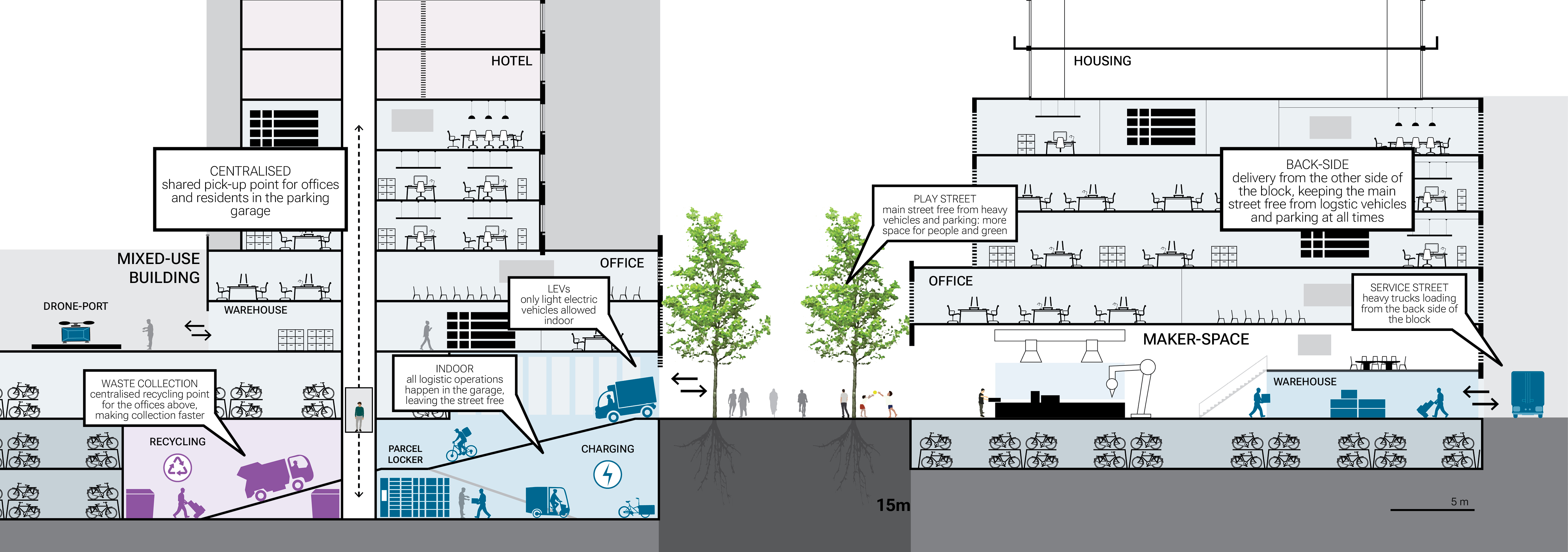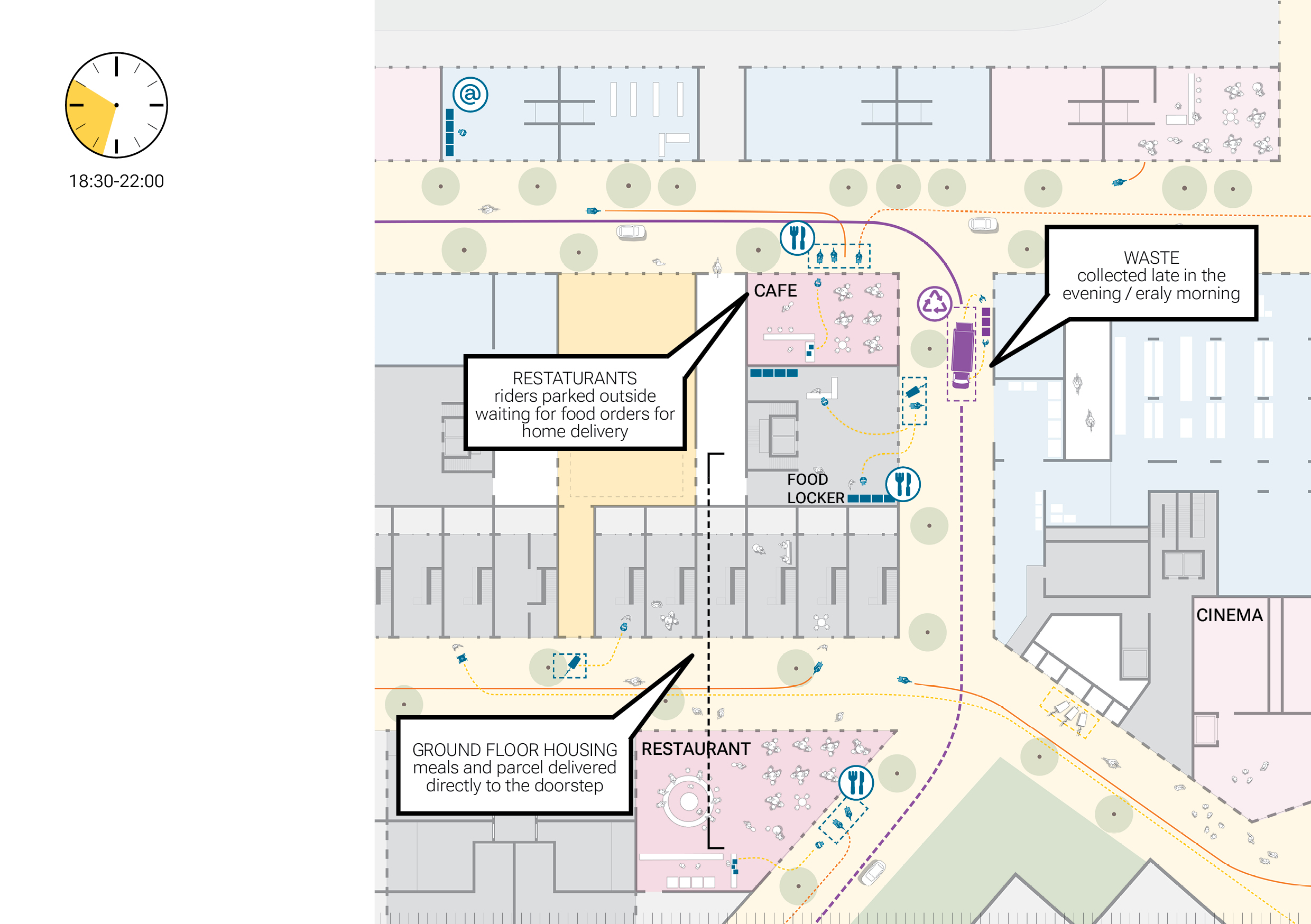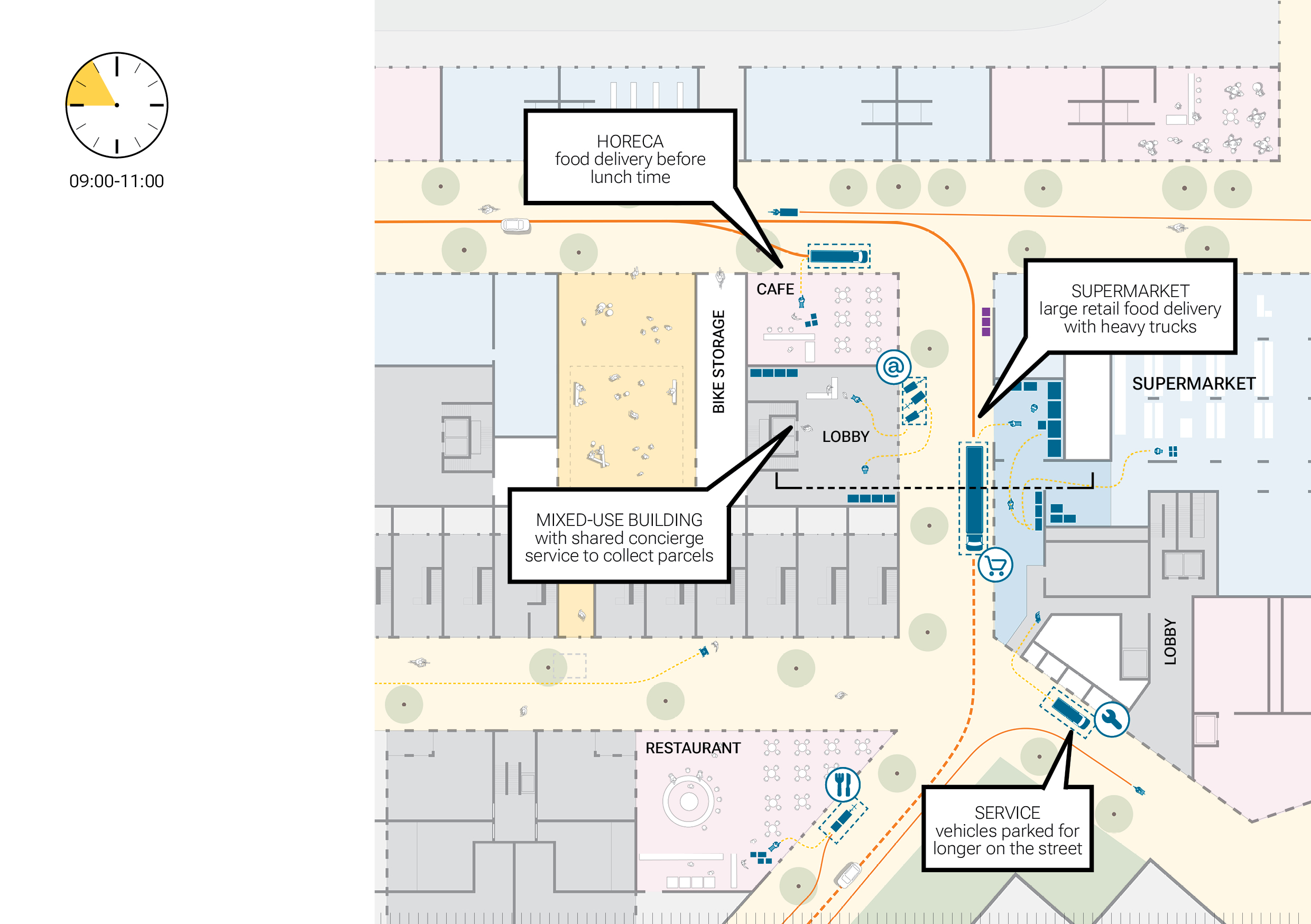FROM LOGISTICS TO PUBLIC SPACE DESIGN
RIDERS ON THE STREET
Why should last mile delivery be part of street design?
New trends and innovations in commerce and delivery have a significant impact on the quality and the use of streets. It is therefore essential to deepen our understanding of the subject and develop new methods (design tools, strategies, models) to integrate present and future demands of logistics. This research focuses on the question of how streets can incorporate this new demand, not as a pure technical issue, but as an opportunity to improve public space, especially streets. Beside spatial design aspects, it is essential to incorporate time into the system. By opening up this idea, we can start designing streets differently, making the same space available at different times for different uses and users.
![]()
The research presents various alternatives and models that can be used in spatial policy, urban plans, and public space projects. And they can be integrated in the periodical upgrades of adaptation/transformation cycles of existing streets or in new streets. A series of solutions to integrate micro and small/medium scale logistics with public space in dense urban environments are shown. In addition to existing research on delivery schemes, digital systems, and different vehicles, this research wants to give an insight on the impact of last mile delivery on streets and offer options to integrate new urban logistics in street design projects.
![Amsterdam Hamerkop]()
![Eindhoven Kleine Berg]()
![Leiden Station Area]()
We worked out three different cases. All in dense urban areas. All with their own particular logistic challenges. The central station area in Leiden, which has an excellent level of public transport offer, is being transformed into a highly mixed urban zone with a great variety of uses and users. Together with a high flow of pedestrians, cyclists, and public transport, this brings particular frictions and possibilities. In Hamerkop, a former industrial area in Amsterdam, the development strategy is to combine residential programme with productive activities (maker-spaces). The challenge here consists in integrating residential and light industrial delivery and logistics in the same street space. The case of Kleine Berg in Eindhoven showcases a typical radial city street with shops and horeca functions and their delivery needs.
AMSTERDAM + Hamerkop
The question in Hamerkop is how to organise the mix of working, leisure, and living programmes, in a high density scenario. Namely, what kind of productive functions (maker-spaces) can be supported within the plan and where can they be conveniently located? We studied the impact of last mile delivery on streets, pointing out several options for organising the different logistics activities on the public space and inside the buildings.
![]()
![]()
![]()
![]()
![]()
![]()
EINDHOVEN + Kleine Berg
Kleine Berg is a typical radial street of the historic centre of Eindhoven. It’s a busy, mainly pedestrian and biking artery, filled with small shops, restaurants and cafés open until late, but also hotels, offices, and dwellings. Here we propose micro-intervention (hub) aimed at minimising the impact of last mile logistics on the street and preserving its distinctive pedestrian-friendly character and lively atmosphere.
![]()
![]()
LEIDEN + Station area (see project page)
The Station Area in Leiden is a high-density, mixed urban district, linked to the main mobility hub of the city. The task here is to work with smart time windows to meet the demands of last mile delivery in relation to other uses and flows. Most of the streets are designed as shared space, which favours flexible use dynamics, such as loading-unloading, parking, sitting on terraces, playing, green spaces.
![]()
![]()
![]()
New trends and innovations in commerce and delivery have a significant impact on the quality and the use of streets. It is therefore essential to deepen our understanding of the subject and develop new methods (design tools, strategies, models) to integrate present and future demands of logistics. This research focuses on the question of how streets can incorporate this new demand, not as a pure technical issue, but as an opportunity to improve public space, especially streets. Beside spatial design aspects, it is essential to incorporate time into the system. By opening up this idea, we can start designing streets differently, making the same space available at different times for different uses and users.
+ de nieuwe ruimte

The research presents various alternatives and models that can be used in spatial policy, urban plans, and public space projects. And they can be integrated in the periodical upgrades of adaptation/transformation cycles of existing streets or in new streets. A series of solutions to integrate micro and small/medium scale logistics with public space in dense urban environments are shown. In addition to existing research on delivery schemes, digital systems, and different vehicles, this research wants to give an insight on the impact of last mile delivery on streets and offer options to integrate new urban logistics in street design projects.



We worked out three different cases. All in dense urban areas. All with their own particular logistic challenges. The central station area in Leiden, which has an excellent level of public transport offer, is being transformed into a highly mixed urban zone with a great variety of uses and users. Together with a high flow of pedestrians, cyclists, and public transport, this brings particular frictions and possibilities. In Hamerkop, a former industrial area in Amsterdam, the development strategy is to combine residential programme with productive activities (maker-spaces). The challenge here consists in integrating residential and light industrial delivery and logistics in the same street space. The case of Kleine Berg in Eindhoven showcases a typical radial city street with shops and horeca functions and their delivery needs.
AMSTERDAM + Hamerkop
The question in Hamerkop is how to organise the mix of working, leisure, and living programmes, in a high density scenario. Namely, what kind of productive functions (maker-spaces) can be supported within the plan and where can they be conveniently located? We studied the impact of last mile delivery on streets, pointing out several options for organising the different logistics activities on the public space and inside the buildings.






EINDHOVEN + Kleine Berg
Kleine Berg is a typical radial street of the historic centre of Eindhoven. It’s a busy, mainly pedestrian and biking artery, filled with small shops, restaurants and cafés open until late, but also hotels, offices, and dwellings. Here we propose micro-intervention (hub) aimed at minimising the impact of last mile logistics on the street and preserving its distinctive pedestrian-friendly character and lively atmosphere.


LEIDEN + Station area (see project page)
The Station Area in Leiden is a high-density, mixed urban district, linked to the main mobility hub of the city. The task here is to work with smart time windows to meet the demands of last mile delivery in relation to other uses and flows. Most of the streets are designed as shared space, which favours flexible use dynamics, such as loading-unloading, parking, sitting on terraces, playing, green spaces.



+ contact us to request more info / book
